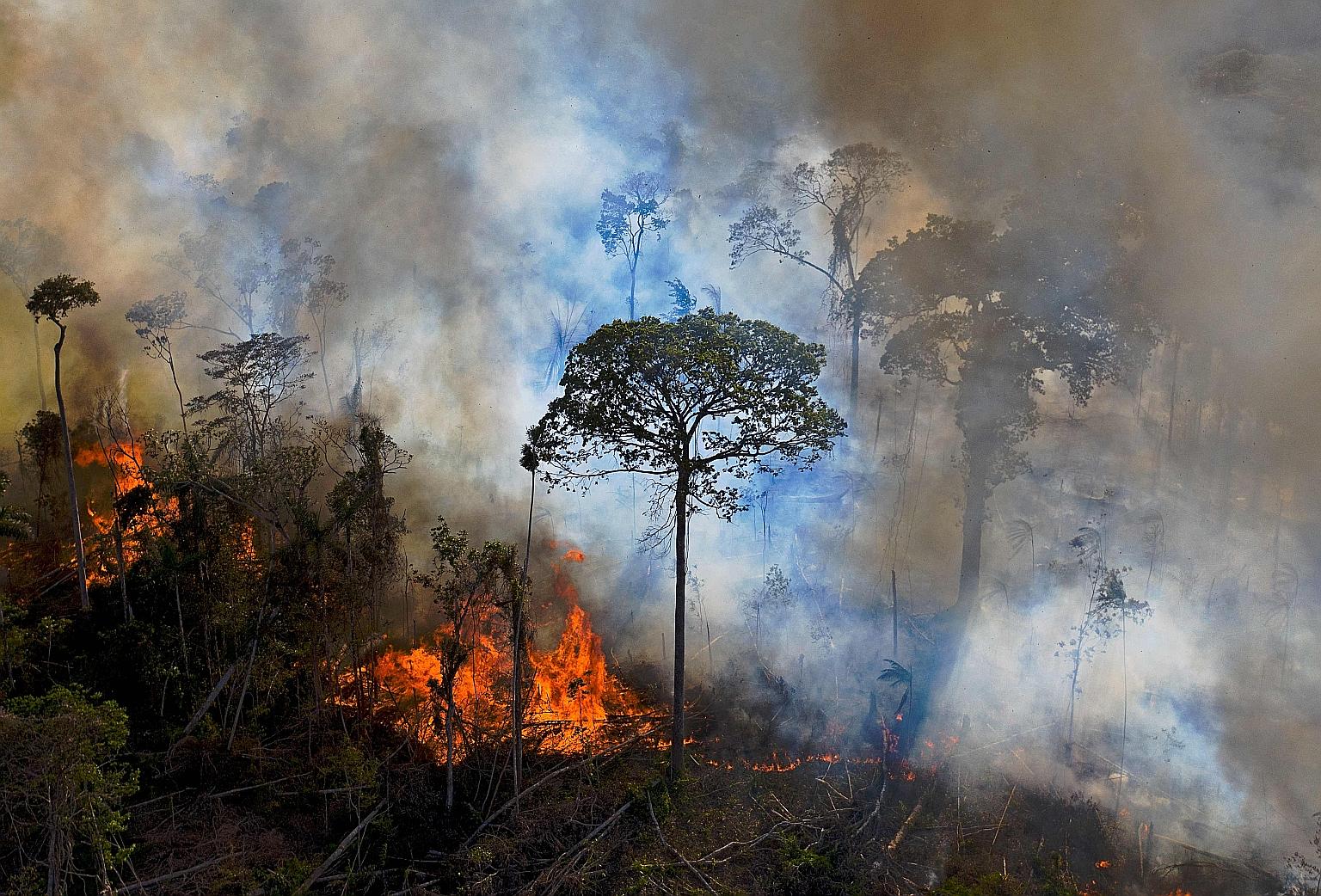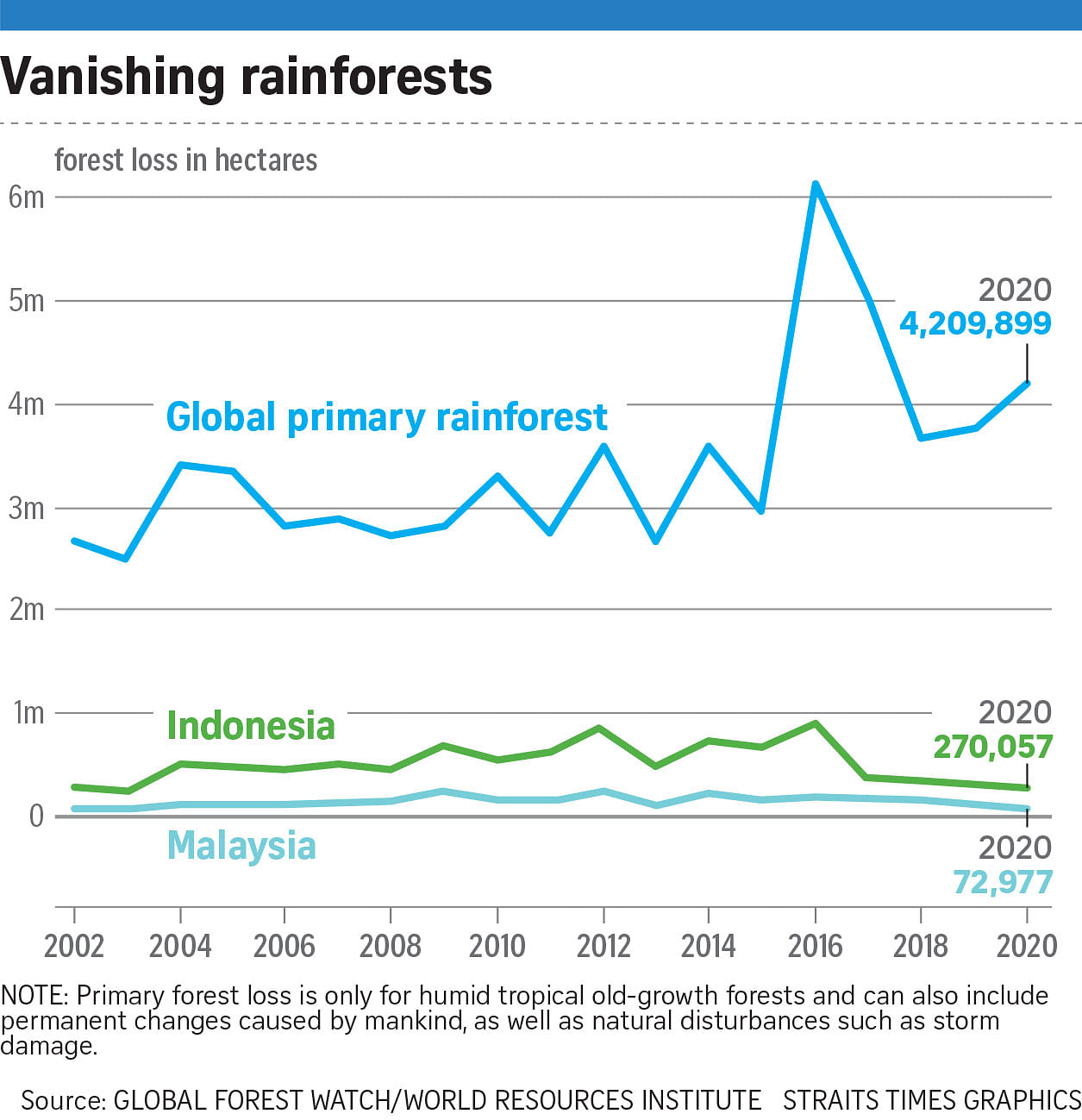Fires a factor behind increased loss of tropical rainforest
Report shows agriculture, climate change also led to destruction of 4.2m ha last year
Sign up now: Get ST's newsletters delivered to your inbox

A photo from last August showing a fire in the Amazon rainforest reserve in Brazil's Para state. A global analysis just out shows primary rainforest loss was highest in Brazil last year, jumping 25 per cent to 1.7 million ha, in part due to severe fires and agriculture.
PHOTO: AGENCE FRANCE-PRESSE
Follow topic:
The world lost an area of tropical rainforest the size of the Netherlands last year, an analysis showed yesterday, accelerating a trend of destruction driven largely by agriculture, fires and climate change.
The findings show nations and companies are far off course from fulfilling their pledges to rapidly reduce the loss of forests, which are critical ecosystems for nature and economies.
A total of 4.2 million ha of primary rainforests were destroyed, up 12 per cent from 2019, causing a major spike in greenhouse gas emissions, loss of biodiversity and loss to indigenous communities heavily reliant on forests for livelihoods, according to the assessment by the University of Maryland, released on the Global Forest Watch online platform of the World Resources Institute (WRI).
Rainforest loss spiked in South America, Central Africa and parts of South-east Asia, including Cambodia and Myanmar. But loss of rainforest fell for a fourth year in Indonesia and Malaysia.
"Every year we ring the alarm bell but we're still losing forests at a rapid clip," WRI senior fellow Frances Seymour told an online briefing ahead of the release of the annual analysis.
Across the tropics, total forest loss was 12.2 million ha, up 2.4 per cent from 2019.
Mr Rod Taylor, global director of WRI's forest programme, said the loss of 4.2 million ha of carbon-rich rainforests caused the release of 2.64 billion tonnes of carbon dioxide-equivalent, about the annual emissions of 570 million cars or about twice the annual greenhouse gas emissions of Japan.
"These dense forests can be hundreds of years old and store significant amounts of carbon. Losing them has irreversible impacts on biodiversity and climate change," he told the briefing.
He said there was no clear sign the Covid-19 pandemic was the cause of increased forest loss, despite fears over fewer patrols and reduced environmental agency budgets or that the return to the countryside of millions of people might fuel deforestation.
The bigger impact could come with the pandemic recovery phase, he said.
A major concern was the impact of climate change on forests, the analysis noted, with high temperatures, drought and intense fires destroying large areas of rainforests and tropical wetlands, as well as forests outside the tropics, in Siberia and southern Australia.

"The most ominous signal from the 2020 data is the number and variety of instances where forests themselves have fallen victim to climate change. Wetlands are burning," said Ms Seymour.
In Australia, the 2019-20 fires resulted in a ninefold increase in tree cover loss last year compared with 2018, totalling nearly 2.5 million ha, according to the analysis.
Fires also tore through Siberian forests, the Amazon and Brazil's Pantanal, the world's largest tropical wetland.
Forests soak up large amounts of CO2 annually and are regarded as a key way to limit the pace of global warming. If they are increasingly vulnerable to fire, drought and pests, that bodes ill for global efforts to fight climate change.
The analysis showed primary rainforest loss was highest in Brazil, jumping 25 per cent to 1.7 million ha last year in part due to severe fires and agriculture. The Democratic Republic of Congo was No. 2, followed by Bolivia and then Indonesia, with Laos at No. 8 and Malaysia No. 9 globally.
Primary rainforest loss fell 17 per cent to 272,057 ha in Indonesia and dropped 40 per cent to 72,977 ha in Malaysia.
Dr Arief Wijaya, climate and forests senior manager at WRI Indonesia, said government policies, wet weather and weaker demand for palm oil helped Indonesia reduce rainforest loss.
Ms Seymour said the pandemic could still be a big risk for forests.
"Think how astonishing it is that in a year the global economy contracted 3 or 4 per cent, primary tropical forest loss increased by 12 per cent," she said. "And there's every reason to believe we haven't yet seen the most significant impacts of the pandemic on forests which will probably come into play as economies start to recover. And unless we offer alternatives, it's likely that governments will try to restart their economies on the backs of forests."

